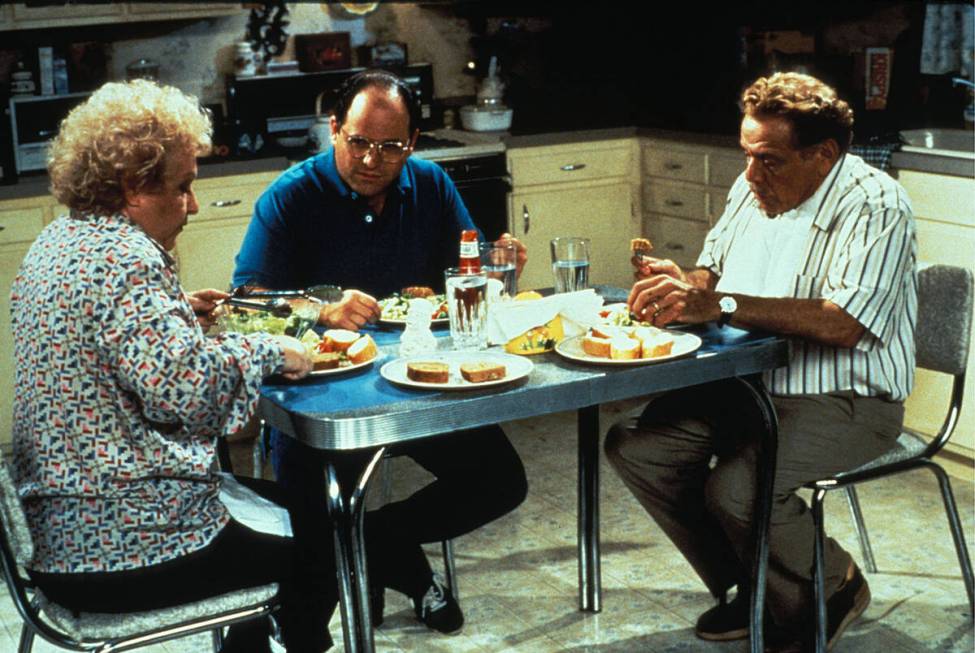How Festivus arrived for the rest of us

Break out the aluminum pole from the crawl space and grease up for the feats of strength, it’s time for Festivus!
If you’re not a “Seinfeld” fan: Festivus, celebrated on Dec. 23 “to get a leg up on Christmas,” is a holiday alternative that replaces high credit card bills with the airing of petty grievances.
The fake holiday that somehow became a real celebration originated in the final season of “Seinfeld,” which celebrates its 25th anniversary this year. Festivus originally appeared in “The Strike,” which you can stream on Netflix or catch in syndication.
But before it was springing from the warped mind of Frank Costanza, Festivus was an all-too real tradition former “Seinfeld” writer Dan O’Keefe and his family endured.
“My brothers and I agreed not to talk about what a … insane childhood we had, particularly, the apotheosis of that, this made up, weird-ass holiday celebrated in the strangest of ways that my father took from a Latin adjective,” O’Keefe told The Inquirer.
For years, O’Keefe kept Festivus a secret from his friends and colleagues. That changed when O’Keefe became a writer on “Seinfeld,” the first of many Festivus miracles.
The real Festivus
There was no aluminum pole. It had no official date. It had absolutely nothing to do with Christmas.
But there were grievances.
O’Keefe said Festivus was invented by his late father, Daniel O’Keefe, who was a writer and editor at Reader’s Digest. What started as a celebration of his parents’ first date morphed into an unpredictable ritual held on random dates where family members had to talk about things that happened during the previous year. Festivus also featured depressing themes, O’Keefe said, such as “Is there light at the end of the tunnel?”
Like Frank, O’Keefe’s father would record the Festivus proceedings. He was inspired by Samuel Beckett’s “Krapp’s Last Tape,” where the main character records himself speaking throughout his life. But the airing of grievances became the driver behind the real holiday.
“My dad would record everything — grievances with Reader’s Digest, anger about the British occupation in Northern Ireland, and just general weirdness,” O’Keefe said. “A lot of it was just discussing how everyone at Reader’s Digest was an a—, and how they were going to get what’s coming to them.”
O’Keefe said his father shared similarities with Frank Constanza, played by the late Jerry Stiller.
“Frank Costanza was a loudmouth guy from Queens, and my dad was a loudmouth, Irish guy from Jersey City. They both shouted a lot, though Frank was a lot less toxic, I guess,” O’Keefe said.
O’Keefe’s father also coined the term, “A Festivus for the rest of us,” which ended up in the show. But it had nothing to do with class consciousness or the fight against Christmas commercialism — it was about the sudden death of O’Keefe’s grandmother in 1976.
“My grandmother, Jeanette Marie O’Connor O’Keefe, had just dropped dead in a supermarket, and my dad loved his mom,” O’Keefe said. “And so he said, ‘This is a Festivus for the rest of us,’ meaning those who remained among the living.”
The O’Keefes’ final Festivus
The final time O’Keefe celebrated his father’s made-up holiday was 1990, the year he graduated college. But it wasn’t by choice.
He and his brothers were home over the summer while their father walked around the house in a thick tweed sports coat. O’Keefe said his father peppered them with weird questions, moving in closely as he listened to their responses. Soon he realized what was happening.
“He had a Reader’s Digest-issued, 1970s vintage tape recorded suspended around his neck on a rope, and he was recording us,” he said.
“That cassette tape ends abruptly when we just walked out of the house. He gave up after that,” O’Keefe said. “I think he and my mom celebrated it after we left the house, and I think that’s how it started, so it’s appropriate it ended with the two of them doing the thing.”
How Festivus ended up on ‘Seinfeld’
O’Keefe was in his 20s when he joined the writing staff of “Seinfeld” during the sitcom’s final season in 1997. His brother spilled the beans about Festivus during a party with “Seinfeld” producers, who wanted it in the show.
“I was concerned for the institution,” O’Keefe recalled. “It’s not just that you want to publicly humiliate me. You want to put this depressingly weird, alcoholic, overeducated slice of 1970s suburbia on ‘Seinfeld’?”
O’Keefe refused to write it into the show, even as Jerry Seinfeld pushed for it to be included. Eventually, they stopped asking and said Festivus was going to end up in the show whether O’Keefe wrote it or not. So he reluctantly agreed, using it as a plot line alongside Kramer returning to work at a bagel shop after striking for 12 years and George giving his coworkers fake donations to a made-up charity he called The Human Fund.
Once O’Keefe realized all the plot lines could come together at the Festivus dinner, he knew he had to tell his father it would appear on the show, which at the time was averaging about 30 million viewers an episode.
“He was kind of annoyed and weirded out, but then he actually felt quite triumphant about it,” O’Keefe said. “Like he’d been proven right about something.”
Twenty-five years later, O’Keefe said he never would have predicted Festivus would have had so much such staying power.
“Jerry was right. There was a version of it that could work, that people would laugh at,” O’Keefe said. “I just couldn’t see it because I was blinded by the actual thing itself.”